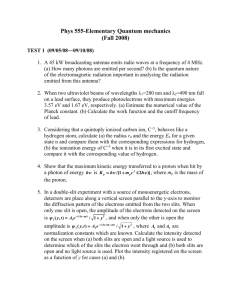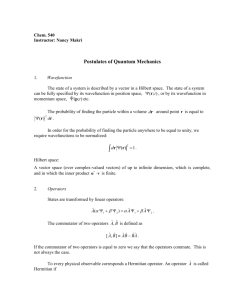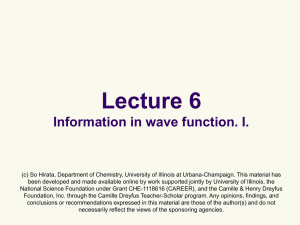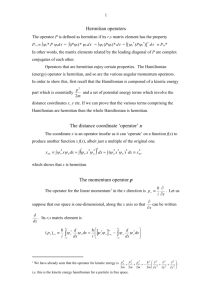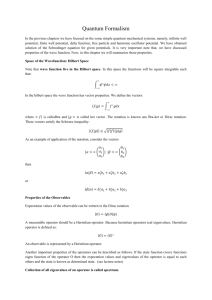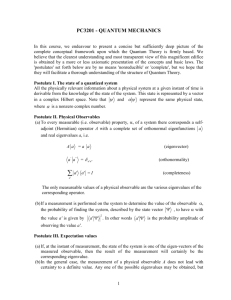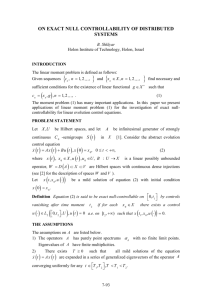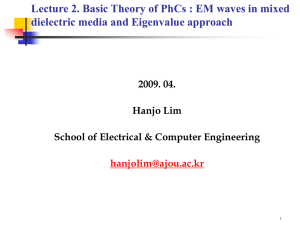REVIEW OF WAVE MECHANICS
advertisement
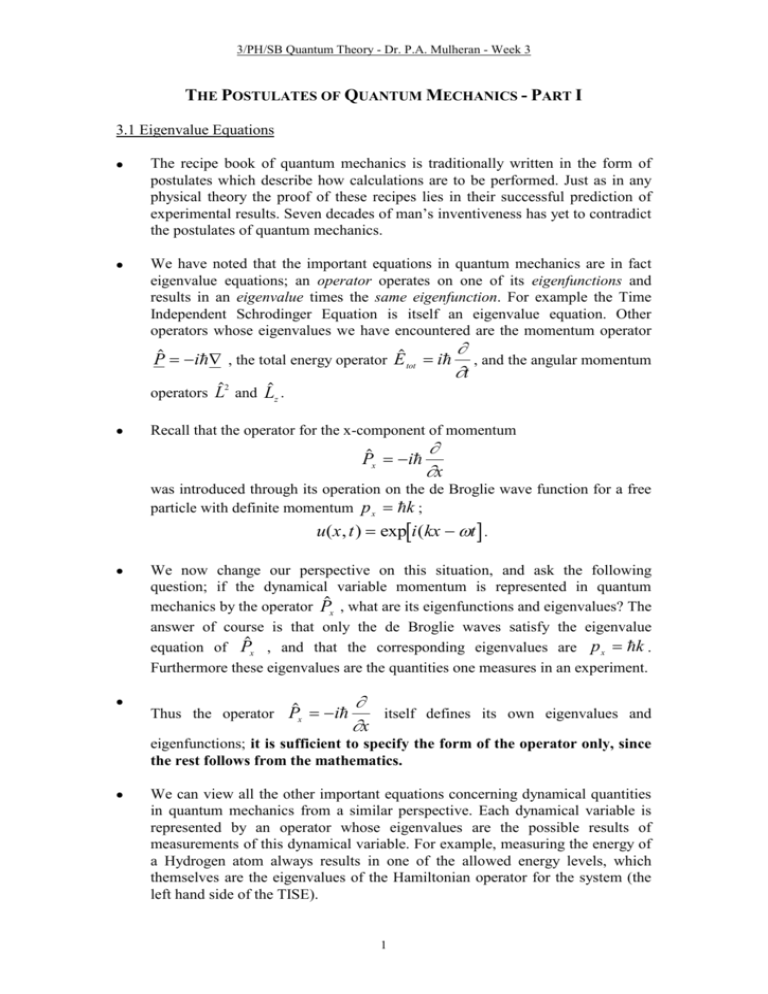
3/PH/SB Quantum Theory - Dr. P.A. Mulheran - Week 3 THE POSTULATES OF QUANTUM MECHANICS - PART I 3.1 Eigenvalue Equations The recipe book of quantum mechanics is traditionally written in the form of postulates which describe how calculations are to be performed. Just as in any physical theory the proof of these recipes lies in their successful prediction of experimental results. Seven decades of man’s inventiveness has yet to contradict the postulates of quantum mechanics. We have noted that the important equations in quantum mechanics are in fact eigenvalue equations; an operator operates on one of its eigenfunctions and results in an eigenvalue times the same eigenfunction. For example the Time Independent Schrodinger Equation is itself an eigenvalue equation. Other operators whose eigenvalues we have encountered are the momentum operator P i , the total energy operator E tot i , and the angular momentum t 2 operators L and L z . Recall that the operator for the x-component of momentum Px i x was introduced through its operation on the de Broglie wave function for a free particle with definite momentum p x k ; u(x , t ) expi (kx t . We now change our perspective on this situation, and ask the following question; if the dynamical variable momentum is represented in quantum mechanics by the operator Px , what are its eigenfunctions and eigenvalues? The answer of course is that only the de Broglie waves satisfy the eigenvalue equation of Px , and that the corresponding eigenvalues are p x k . Furthermore these eigenvalues are the quantities one measures in an experiment. Thus the operator Px i itself defines its own eigenvalues and x eigenfunctions; it is sufficient to specify the form of the operator only, since the rest follows from the mathematics. We can view all the other important equations concerning dynamical quantities in quantum mechanics from a similar perspective. Each dynamical variable is represented by an operator whose eigenvalues are the possible results of measurements of this dynamical variable. For example, measuring the energy of a Hydrogen atom always results in one of the allowed energy levels, which themselves are the eigenvalues of the Hamiltonian operator for the system (the left hand side of the TISE). 1 3/PH/SB Quantum Theory - Dr. P.A. Mulheran - Week 3 3.2 The First Three Postulates P1 For every dynamical system there exists a single-valued, normalisable wave function from which all possible predictions of the physical properties of the system can be obtained. P2 Every dynamical variable may be represented by a linear Hermitian operator whose eigenvalue spectrum is the set of all possible results of a measurement of that variable. P3 The operators representing position and momentum of a particle are r and i respectively for wave functions written as a function of position. The operators for other dynamical variables can be found from the corresponding classical relation between P and r (e.g. H T V used in the TISE). 3.3 Definition of a Hermitian Operator The operator Q is Hermitian if and only if it satisfies the following relation: ( r ). d g ( r ). Q * f ( r ). d f (r ). Qg allspace allspace for any well-behaved (i.e. physically realistic) functions f(r) and g(r) that vanish for | r| . N.B. The operator operates on the functions to its right, so in general ( r ) f ( r ). Q . Qf It is easily shown that the operators for position and momentum defined above are Hermitian. 3.4 Properties of Hermitian Operators The eigenvalues of Hermitian operators are real, which is why they are so convenient to use in quantum mechanics; physical measurements produce real answers! The eigenfunctions of a Hermitian operator are orthogonal to one another. This leads to another element of quantum theory, namely the Superposition Principle, which provides the basis for the quantum theory of measurement. 2 3/PH/SB Quantum Theory - Dr. P.A. Mulheran - Week 3 3.5 The Superposition Principle We will assume that the eigenfunctions of Hermitian operators form complete sets. This means that any well-behaved, physically reasonable wave function ( r ) can be written as a unique linear superposition of eigenfunctions u n ( r ) : (r ) a n un (r ) . n The coefficients (or amplitudes) in this expansion, a n , can easily be found by utilising the orthogonality of the eigenfunctions: a n un * (r ). (r ). d , allspace where we assume that the wave function ( r ) and the eigenfunctions u n ( r ) are all normalised. of a Hermitian operator Q can now be evaluated The expectation value Q for a general wave function utilising the superposition principle. The expansion can be made in the most convenient complete set of states, so in this case we obviously use the eigenfunctions of this particular operator Q : (r ) a n un (r ) , n where n (r ) q n un (r ) , Qu so that Q | a n |2 q n . n But postulate P2 states that the eigenvalues q n are the only possible results of measurements of the dynamical variable represented by Q . Thus the , which is the average of a large number of expectation value Q measurements, will be given by Q Pn q n , n where Pn is the probability of measuring the nth eigenvalue. Thus we identify Pn | a n |2 as the probability of a measurement of the dynamical variable represented by the operator Q yielding the result q n , where the amplitude a n is calculated as above using the wave function of the system. This identification of | a n | as a probability is consistent with | (r )| being the probability of measuring the particle at a certain position, and it is also consistent with the sum of probabilities being unity since (r ) is normalised. 2 2 3 3/PH/SB Quantum Theory - Dr. P.A. Mulheran - Week 3 WORKSHOP QUESTIONS Hand your solutions to the following questions to Dr. Mulheran at the start of the next-but-one workshop. Some of your solutions will be marked as part of the continuous assessment of this course which contributes 20% of the overall module grade. Your solutions must be well presented; untidy work will be penalised. 3.1 Write down the eigenvalue equation for the total energy operator , E tot i t and solve this equation for both the eigenfunctions and the eigenvalues. Comment on how your solution relates to de Broglie waves for free particles, and how it is used in transforming the Time Dependent Schrodinger Equation into the Time Independent form. [5 marks] 3.2 Find the eigenvalues and eigenfunctions of the momentum operator P̂ i . [5 marks] Hint: Use Cartesian co-ordinates. 3.3 (a) (b) (c) 3.4 . Is Show that if the operator Q is Hermitian then so is the operator Q the kinetic energy operator Hermitian? [3 marks] Show that any real function of position V(r) is Hermitian. [1 mark] Hence show that the Hamiltonian operator is Hermitian. [1 mark] 2 A particle is in a one-dimensional infinite square well of width L. At some moment in time its wave function is 2 3 x 4 x 4 , 0 x L, sin sin u( x ) 3L L . 3L L 0 otherwise . (a) Evaluate H and the uncertainty in the energy E using the integral formulae given in week 2 of this course. [3 marks] (b) What are the possible results of measuring the particle’s energy, and what are the probabilities of these results occurring? Do your answers agree with those of part (a)? [2 marks] 4 3/PH/SB Quantum Theory - Dr. P.A. Mulheran - Week 3 WORKSHOP SOLUTIONS 3.1 i v( t ) E . v( t ) t The solutions are that the eigenfunctions v( t ) exp( i t ) and the eigenvalues E . This is the time-dependent part of the de Broglie wave exp i ( kx t ) for a free particle with definite momentum and energy. It is also the time dependent part of the wave function for any particle with definite total energy E . The Time Dependent Schrodinger Equation is H (r , t ) i (r , t ) , t where the spatial and time dependencies are separable. Thus the wave function can be written as a product of an r-dependent function and a t-dependent function, (r , t ) u(r ). v(t ) , and v(t) is an eigenfunction of the total where u(r) is an eigenfunction of H energy operator as given above. 3.2 Pˆ i j k 2 y z x Thus the eigenvalue equation Pˆ u x, y , z p.u x, y , z is separable and the wave function can be expressed as a product of one dimensional functions obeying d i u1 ( x ) p1u1 ( x ) , dx and similar for the other co-ordinates. This last equation has the solution u1 ( x ) exp(ik 1 x ) as its eigenfunctions and p1 k1 as its eigenvalues. Thus the total solutions for the eigenvalue equation for the momentum operator are the eigenfunctions u( x , y , z) u1 ( x ). u 2 ( y).u 3 ( z) exp(ik 1 x ). exp(ik 2 y). exp(ik 3 z) expi ( k 1 x k 2 y k 3 z) exp(ik . r ) and eigenvalues p k1 i k 2 j k 3 k K . 3.3 (a) Put f (r ). Q . Q . g(r ). d allspace f (r ). Q . h(r ). d allspace (r ) , i.e. the function resulting from Q operating on g(r). where h(r ) Qg Now use the definition of the Hermitian operator on the right hand side: 5 3/PH/SB Quantum Theory - Dr. P.A. Mulheran - Week 3 (r ). d h(r ). Q * f (r ). d h(r ). i (r ). d , f (r ). Qh * operating on f(r). Changing the where the function i(r) is the result of Q order in which the product of functions is written in the right hand integral we find (r ). d g(r ). Q * i (r ). d i(r ). h(r ). d i(r ). Qg where the definition of a Hermitian operator has been used again. Finally writing out i(r) in full, we have shown that (r ). d g(r ). Q * Q * f (r ). d , f (r ). QQg allspace allspace Q is also Hermitian. i.e. that QQ 2 We know Px is Hermitian, hence so is Px . Similarly for the y and z components of the kinetic energy operator. (b) The product of three functions is independent of the order in which they are written, thus 2 f (r ).V (r ). g (r ). d allspace g (r ).V (r ). f (r ). d allspace g (r ).V * (r ). f (r ). d allspace for any real function of position V(r). T V (r ) clearly Hermitian from above. (c) H 3.4 (a) u( x ) 1 3 u3 ( x) 2 u4 ( x) 3 2 d 2 u( x ) Hˆ u * ( x ). .dx 2 2 dx 0 L E 3 2 E 4 2 2 3 2 2.4 2 41 2 2 3 3 3 2 L2 3 6L2 since the eigenfunctions u1 and u2 are orthogonal. Similarly E 2 2 E 42 4 4 34 2.4 4 593 4 4 . Hˆ 2 3 3 2 4 3 3 4 2 L4 3 12 L Thus 2 2 593 41 2 2 E Hˆ 2 Hˆ 2 6 . 53 . 12 6 L2 L2 (b) Individual measurements result in energy E 3 with probability 1/3, and energy E 4 with probability 2/3, using the fact that u(x) is a linear superposition 1 of the eigenfunctions of H with amplitudes a 1 and a 2 3 6 2 . 3
